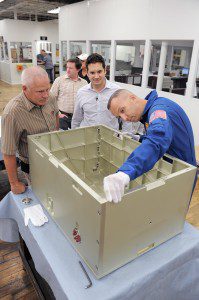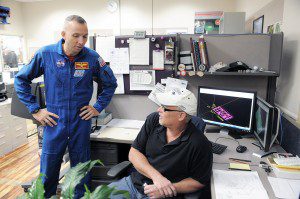
Randy Bresnik, right, an astronaut on the STS-129 Atlantis, uses a pair of white cloth gloves to check a specially designed aluminium shipping container that will be used to transport spacesuits to and from the International Space Station as Advance Manufacturing Plant Manager, left, Tom Scott-Smith and Jeffrey Amanti, center, production manager, monitor the informal inspection. Bresnik and a handful of Johnson Space Center employees visited the plant Friday where the $50,000 container was constructed. (Photo by Frederick Gore)
WESTFIELD – Friday started just like any other at Advance Manufacturing on Turnpike Industrial Park Road, a hustling, bustling paragon of the manufacturing might of western Massachusetts.
But there was something different in the air this morning, as representatives from the National Aeronautics and Space Administration and the Johnson Space Center were visiting to inspect Advance’s work on a device resembling a metal suitcase which they have produced to transport spacesuits to the International Space Station.
Following an incident during a July 16 spacewalk in which Italian astronaut Luca Parmitano nearly drowned due to a water leak malfunction in his suit, and with another suit on the station due for a service, Advance has been commissioned to create a device that will accommodate the transportation of these essential suits to the brave men and women serving on the International Space Station.
“They (NASA) are in kind of an emergency situation, where if something happens, they may not have enough spacesuits to meet their needs,” said Jeffrey Amanti, production manager for Advance.
“We’re making a box where the spacesuit will be placed and launched up to the space station in a cargo ship, which will be grabbed by the station, take the new suit, replace it with the old one, and send it back down for maintenance,” he said.
Amanti explained that after the suit malfunction on the July spacewalk, NASA is looking to send up a repaired suit on an unmanned SpaceX mission scheduled for December of this year.

Randy Bresnik, left, an astronaut on the STS-129 Atlantis, and Carl Nolan, right, a programmer at Advance Manufacturing in Westfield, discuss a new specially designed aluminum container that the company manufactured which will be used to store and transport spacesuits to and from the International Space Station. (Photo by Frederick Gore)
“Our engineers are working with rocket scientists from Hamilton Sundstrand, who are working with NASA and Johnson on this box, to develop it and get it on the aircraft as quick as possible,” he said.
When asked what were the most exciting aspects of the project, Amanti replied that “it’s cool for me to see my guys working with rocket scientists” and that “the size and weight and the urgency of getting the suit up to the station” were the most special aspects of the box itself, which measures out at 2 feet by 2 feet by 3 feet.
The delegation from NASA was made up of Hardware Manager Kevin Wells, Engineer Brian Macias, Mission Operations Directorate Megan Murphey and Astronaut Randy Bresnik, who inspected every nook and cranny of the box himself with special gloves to make sure it was as finely manicured as possible.
“The crew does sharp edge inspections on all parts to prevent injuries to astronauts in space,” said Wells. “The suit has four points which are attached to the inside of the box, which will then be attached to the cargo craft.”
Wells would add that all fasteners on the box are captive in their panels and that each part is inspected meticulously before it is launched into space.
“You really get an appreciation for these parts,” said Murphey. “A five cent screw at your local hardware store costs like $90 for one of these.”
When the question of cost came up, the estimates ranged vastly.
“We’re not too sure yet,” said Glen Kwolek, a senior buyer for Hamilton. “We’re still working on a final number.”
“It’ll be around $50,000,” said Todd Scott-Smith, plant manager at Advance, before adding that the box “is going to be used a multitude of times.”
“It’s a one shot deal, though,” he said pointing at the intricate honeycomb construction of the box’ interior. “You got to get it right the first time. It’s a lot of nuts and bolts that’ve got to be accurate.”
“It’s certainly one of the most expensive boxes I’ve ever made,” he chuckled.
While the box was certainly the star of the afternoon’s show, astronaut Bresnik was a close second, standing out like a superhero amid the passing, overall-clad machinists in his blue NASA jumpsuit.
Bresnik, a Colonel in the United States Marine Corps, is in his ninth year as a NASA astronaut, and said that it was always his dream to fly.
“Kids dream about it, but I never thought it was possible,” he said.
After attending The Citadel on a Marine Corps scholarship, the Santa Monica, Calif. native worked as a marine aviator before being selected as a member of NASA Astronaut Group 19 in May 2004.
“It was a lot of school and hard work,” said Bresnik. “NASA is filled with people who love what they do. They’re all well-rounded. Many of them could’ve climbed Mount Everest or become concert pianists. There is a wide pool of experiences and talents to choose from.”
When asked of how the current situation in Washington is affecting his organization, Bresnik said that 97 percent of NASA employees have been furloughed, but that the three percent that are currently still working have been deemed essential by Capital Hill.
“The ability to do repairs to the space station is essential,” he said. “As are those employees in mission control and the astronauts on the station. We hope it’s resolved quickly.”
“During the shutdown, any work that is done must be required for safe operation,” added Wells. “And spacesuits are required (for safe operation).”
When asked of the attitude of those employed by NASA on the ground regarding the shutdown, Wells kept it short and sweet.
“How’re we dealing with it? We’re working and we hope we get paid,” he said with a smile.
Despite the stress of the situation in D.C., the NASA delegation was in good spirits all morning, shaking hands, laughing, and making small talk about the accuracies and inaccuracies of the new film “Gravity”.
Asked of how many times astronauts have visited his company, Amanti grinned.
“Several times. Three or four times over the years,” he said, smiling a smile indicating that each time is just as exciting as the first. “It’s a pleasure for us, because without them… they make the space program possible.”

